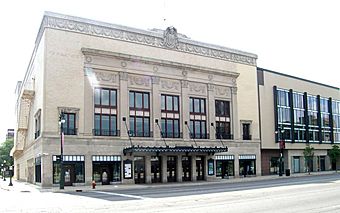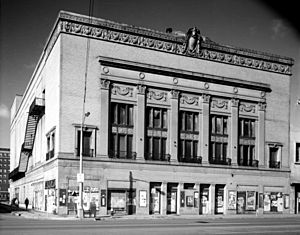Orchestra Hall (Detroit) facts for kids
|
Paradise Theater
|
|

Orchestra Hall and Max M. and Marjorie S. Fisher Music Center
|
|
| Address | 3711 Woodward Avenue Detroit, Michigan United States |
|---|---|
| Operator | Detroit Symphony Orchestra |
| Type | Concert hall |
| Capacity |
|
| Construction | |
| Opened | 1919 |
| Reopened | 1989, 2003 |
|
Orchestra Hall
|
|
| Architect | C. Howard Crane |
| Architectural style | Beaux-Arts |
| NRHP reference No. | 71000429 |
| Added to NRHP | April 16, 1971 |
Orchestra Hall is a famous concert hall located at 3711 Woodward Avenue in Midtown Detroit, Michigan, United States. This hall is well-known for its amazing sound quality. It is the home of the Detroit Symphony Orchestra (DSO), which is one of the oldest orchestras in the United States. In 2003, Orchestra Hall became part of a larger complex called the Max M. and Marjorie S. Fisher Music Center. This new center includes an extra auditorium for jazz and chamber music. Orchestra Hall was added to the National Register of Historic Places in 1971. This means it is recognized as an important historical building.
Contents
History of Orchestra Hall
Building a Musical Home
The Detroit Symphony Orchestra used to play at the old Detroit Opera House. However, their music director, Ossip Gabrilowitsch, wanted a better place. He said the DSO needed a proper auditorium before he would take his job. So, construction on Orchestra Hall began on June 6, 1919. It was built very quickly, in just six months!
The hall was designed by C. Howard Crane, a famous architect who designed theaters. It had 2,014 seats for people to watch concerts. The very first concert took place on October 23, 1919. Orchestra Hall was the home of the Detroit Symphony Orchestra until 1939.
From Orchestra to Paradise
During the Great Depression, a time when many people faced financial hardship, the orchestra had money problems. They had to leave Orchestra Hall. They moved to the Masonic Temple Theatre to save money. Orchestra Hall was empty for two years after the DSO left.
Then, new owners bought the hall. For ten years, Orchestra Hall became a place for jazz music. It was renamed the Paradise Theater. It opened on Christmas Eve in 1941. The Paradise Theater hosted many famous jazz musicians. These included Ella Fitzgerald, Billie Holiday, Count Basie, and Duke Ellington. Shows at the Paradise Theater often had live music and a movie.
Saving a Historic Hall
The Paradise Theater closed in 1951. Orchestra Hall was empty again for almost 20 years. In the late 1960s, there were plans to tear it down. They wanted to build a restaurant on the land. But Paul Ganson, a musician with the DSO, led a group to save the hall. They worked to find the hall again and raise money to fix it up.
Renovation work started in 1970. It continued for about two decades, costing around $6.8 million. The original building needed many repairs. This included a new stage, new seats, and fixing the plaster and decorations. All the repair work was done carefully. The goal was to keep the excellent sound quality that the hall was known for. Orchestra Hall was added to the National Register of Historic Places in 1971. The Detroit Symphony Orchestra moved back into Orchestra Hall in 1989.
The Max M. and Marjorie S. Fisher Music Center
More work was done on the hall in the summers of 2002 and 2003. This was part of creating the new Max M. and Marjorie S. Fisher Music Center. People often call it "the MAX." This project included fixing up the old building. It also added new parts like more lobbies and reception areas. There are also dressing rooms, storage, and rehearsal spaces. A new 450-seat venue was added for smaller, more personal performances.
Today, the mayor of Detroit gives the annual State of the City address at Orchestra Hall.
See also
 In Spanish: Orchestra Hall para niños
In Spanish: Orchestra Hall para niños


